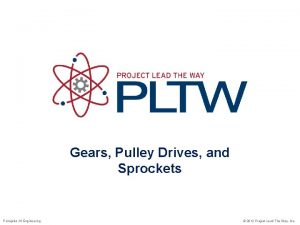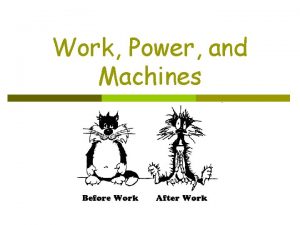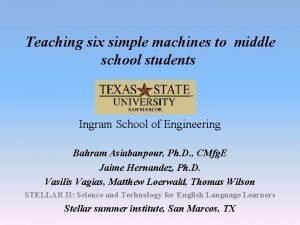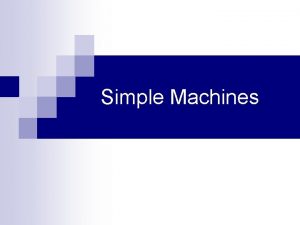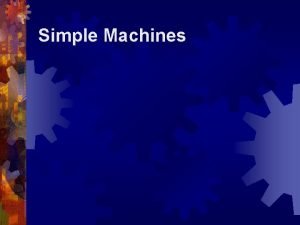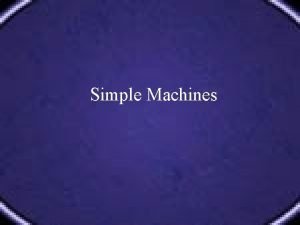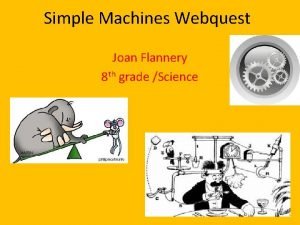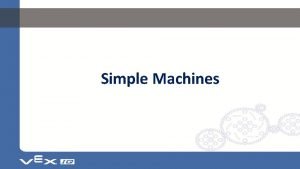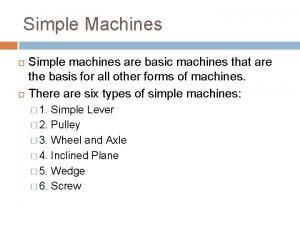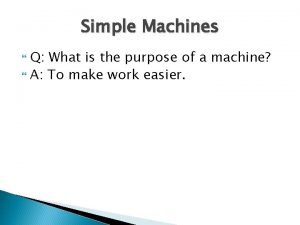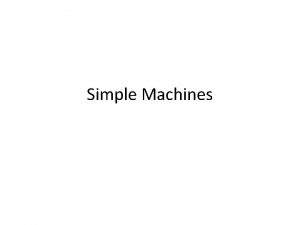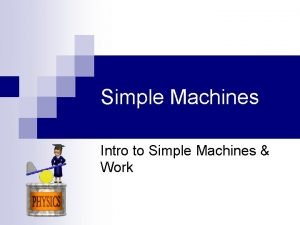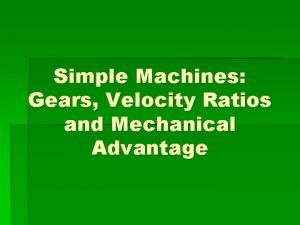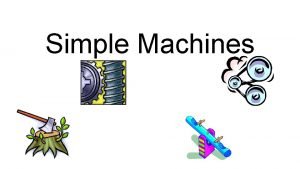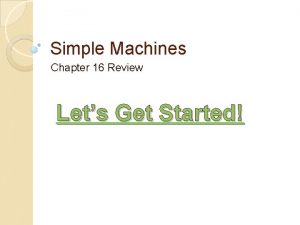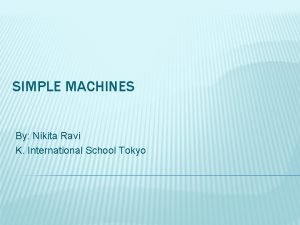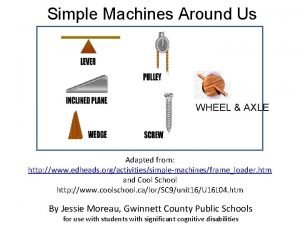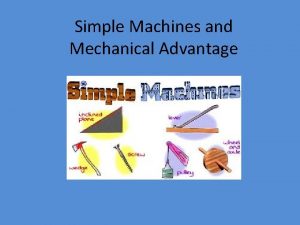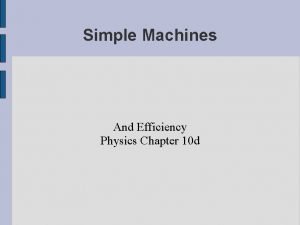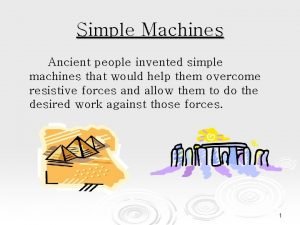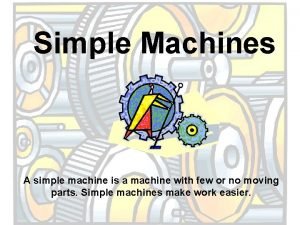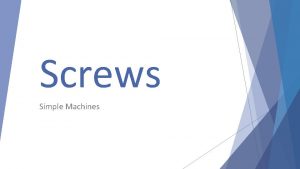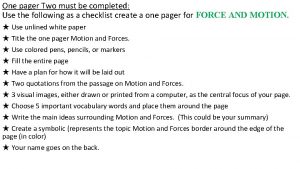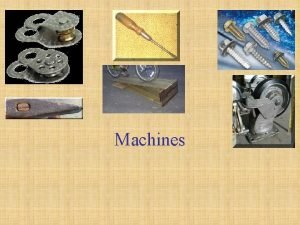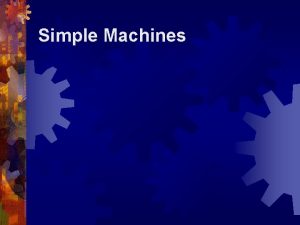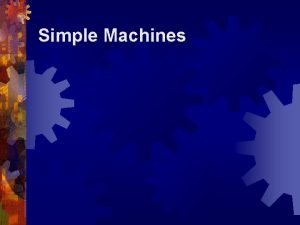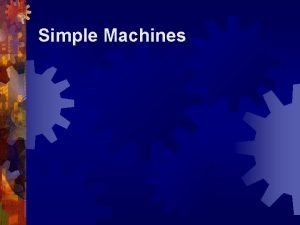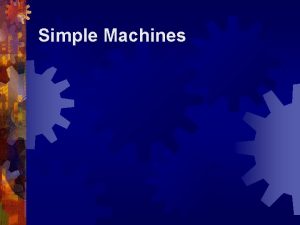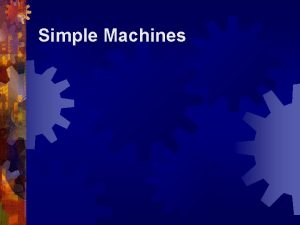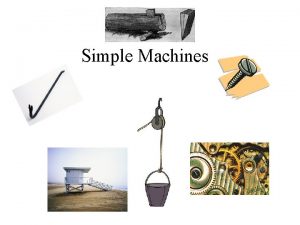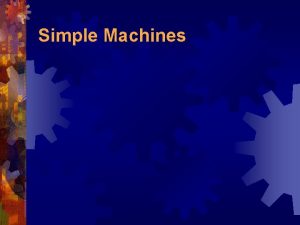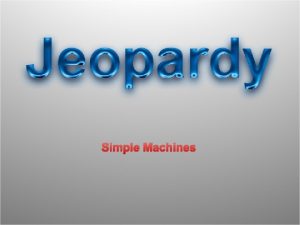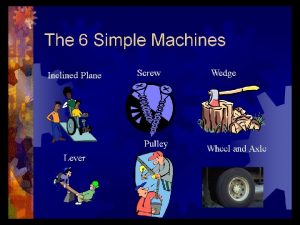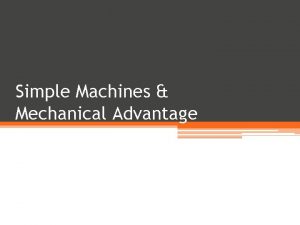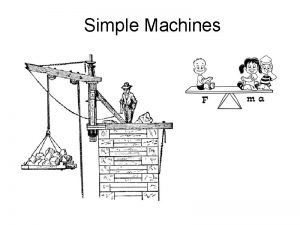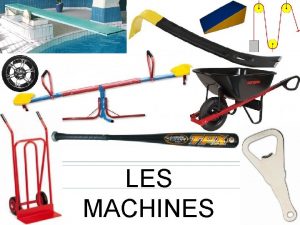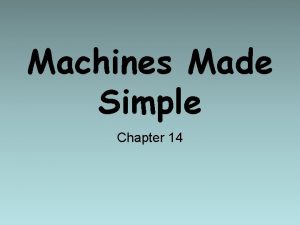Simple Machines Mr Hunsaker What is a Machine

































- Slides: 33

Simple Machines Mr. Hunsaker

What is a Machine? n A device that allows you to do work in a way that is easier or more effective. n A machine can do at least one of these 3 things: 1. Change the amount of force 2. Change the direction of the force 3. Cut down the amount of friction

Inclined Plane Pulley Wedge Simple Machines Wheel & Axle Screw Lever

The Inclined Plane Ø An inclined plane is a flat, slanted surface Ø It allows you to exert your force over a longer distance

Inclined Plane Ø Inclined planes make it easier to get things up higher or down lower Ø You can roll or slide things on a ramp

Types of Inclined Planes ØRamps ØStairs ØRoads ØThe steeper the slant…the more work it takes to go up the inclined plane

Inclined Plane

The Wedge n A wedge is a device that is thick at one end and tapers to a thin edge at the other end n In a wedge, instead of an object moving along the inclined plane, the inclined plane itself moves.

Wedge Uses n A wedge is used for cutting, splitting, or prying things apart. n Zippers use wedges to push 2 sides together.

Types of Wedges n Axe n Zipper n Chisel n Razor Blade n A wedge can change the direction of the force. When you use a wedge to pry, not as much force is needed.

The Wedge

The Screw n A screw can be thought of as an inclined plane wrapped around a cylinder. n A screw changes the direction of the force, meaning as you turn it, it goes up or down.

The Screw n A screw is really an inclined plane. The ridges around it are like a road up a mountain. n The ridges on a screw are called threads.

Types of Screws n Jar lid n Water faucet n Car jack n Bolts

The Screw

The Lever n A lever is a rigid bar that is free to pivot or rotate around a fixed point. n The fixed point that the lever pivots around is called the fulcrum.

3 Types of Levers n 1 st Class Lever - the pivot (fulcrum) is between the effort and the load. Number of Class 1 Levers Used Item a single class 1 lever hammer’s claws a single class 1 lever see-saw scissors 2 class 1 levers pliers 2 class 1 levers

3 Types of Levers n 2 nd Class Lever - the load is between the pivot (fulcrum) and the effort. Number of Class 2 Levers Used Item bottle opener wheelbarrow a single class 2 lever a single class 2 lever nail clippers Two class 2 levers nut cracker Two class 2 levers

3 Types of Levers n 3 rd Class Lever - the effort is between the pivot (fulcrum) and the load. Number of Class 3 Levers Used Item fishing rod Two class 3 levers tweezers tongs a single class 3 lever Two class 3 levers

Examples of Levers n Seesaw n Crowbar n Chopsticks n A lever increases the effect of your input force and changes the direction of your input force.

The Lever

3 classes of levers

The Wheel and Axle n A wheel and axle is a modification of a pulley. n A wheel is fixed to a shaft. The wheel and shaft must move together to be a simple machine. n Sometimes the wheel has a crank or handle on it.

The Wheel and Axle n The wheel and axle, moves objects across distances. n The wheel, the round end, turns the axle, the cylindrical post, causing movement.

Wheel & Axle

The Pulley n Instead of an axle, the wheel could also rotate a rope or cord. n This variation of the wheel and axle is the pulley. n In a pulley, a cord wraps around a wheel. As the wheel rotates, the cord moves in either direction.

Types of Pulley n Now, attach a hook to the cord, and you can use the wheel's rotation to raise and lower objects. n On a flagpole, for example, a rope is attached to a pulley. The cord rotates around the pulley and lowers the hooks where you can attach the flag. Then, rotate the cord and the flag raises high on the pole. n A crane uses a simple machine called a pulley to lift things. Our crane uses a pulley to move the metal beams from the ground to the air.

The Pulley

Mechanical Advantage n MA = Is determined differently for each type of simple machine n Force Measured in Newtons n Distance Measured in Meters Mechanical advantage is the number of times a force exerted on a machine is multiplied by the machine. If this # is greater than 1 the machine is extremely useful There are 2 types of Mechanical Advantage

Output Force Actual Mechanical Advantage = Input Force The actual mechanical advantage (AMA) is the mechanical advantage of a real machine. Actual mechanical advantage takes into consideration real world factors such as energy lost in friction The ideal mechanical advantage (IMA), or theoretical mechanical advantage, is the mechanical advantage of an ideal machine. It is usually calculated using physics principles because there is no ideal machine. Each individual Machine has it’s own formula

Mechanical Advantage

Go home and find 3 “real life” examples of each simple machine. n 3 Inclined Planes n 3 Wedges n 3 Screws n Levers n 1 1 st Class Lever n 1 2 nd Class Lever n 1 3 rd Class Lever n 3 Wheels and Axels n 3 Pulleys

References http: //www. cosi. org/online. Exhibits/simp. Ma ch/sm 2. html n www. Unitedstreaming. com n Microsoft clipart n
 Gears and pulley
Gears and pulley Chapter 10 energy, work and simple machines answer key
Chapter 10 energy, work and simple machines answer key Find the efficiency of a machine that does 800 j
Find the efficiency of a machine that does 800 j Define a slogan
Define a slogan Examples of wedges
Examples of wedges Simple machines mikids
Simple machines mikids Slide is a simple machine
Slide is a simple machine Bicycle
Bicycle 6 types of simple machines
6 types of simple machines Simple machines webquest
Simple machines webquest Define compound machines
Define compound machines 6 simple tools
6 simple tools Simple machine description
Simple machine description Simple machine families
Simple machine families What is it called
What is it called Function of simple machine
Function of simple machine All types of simple machines
All types of simple machines Example of screw
Example of screw What are the six types of simple machines
What are the six types of simple machines Gear velocity ratio formula
Gear velocity ratio formula Types of simple machines
Types of simple machines What kind of simple machine is a jar lid
What kind of simple machine is a jar lid Stapler simple machines
Stapler simple machines Screw simple machines
Screw simple machines A simple machine that is a flat, sloped surface
A simple machine that is a flat, sloped surface Efficiency of simple machines
Efficiency of simple machines Who invented simple machines
Who invented simple machines Simple machine examples
Simple machine examples Simple machines examples
Simple machines examples Types of pulley
Types of pulley One pager checklist
One pager checklist An inclined plane wrapped around a rod
An inclined plane wrapped around a rod Example of simple machine
Example of simple machine Types of simple machines
Types of simple machines
